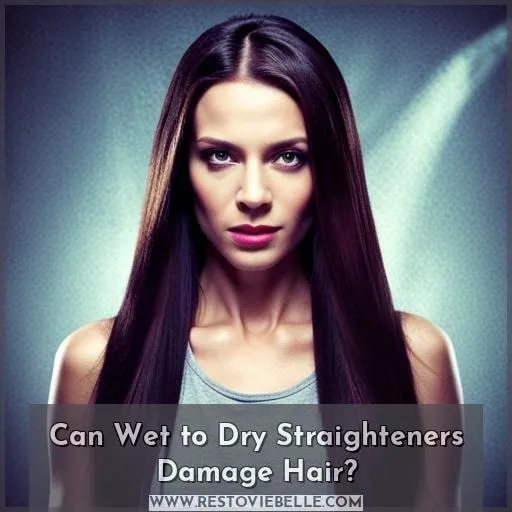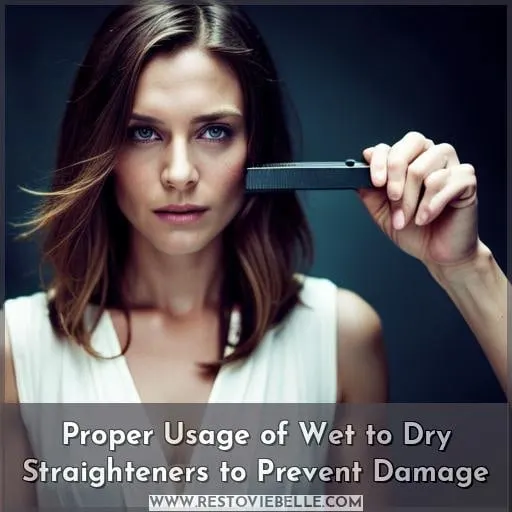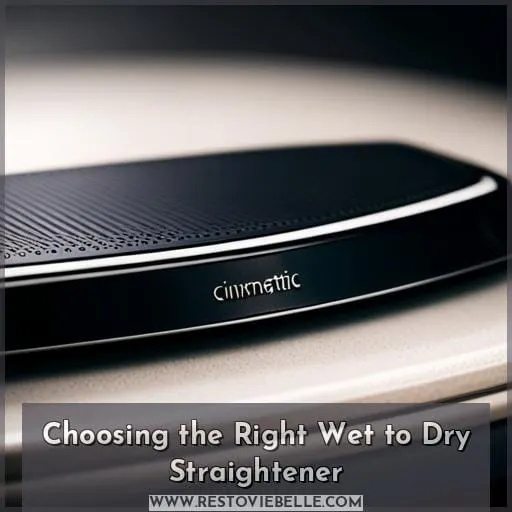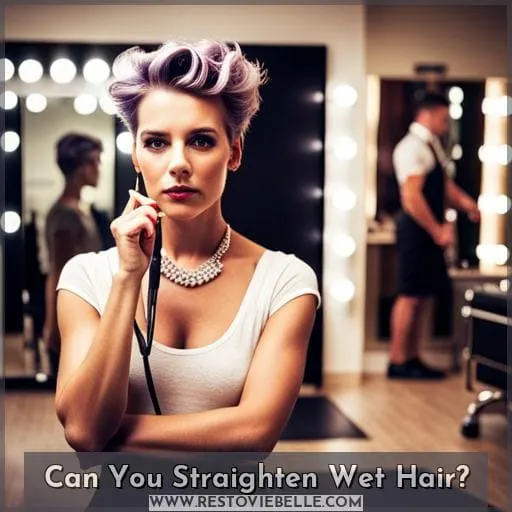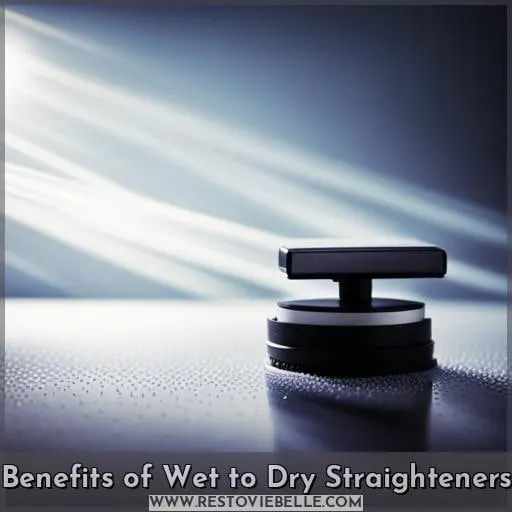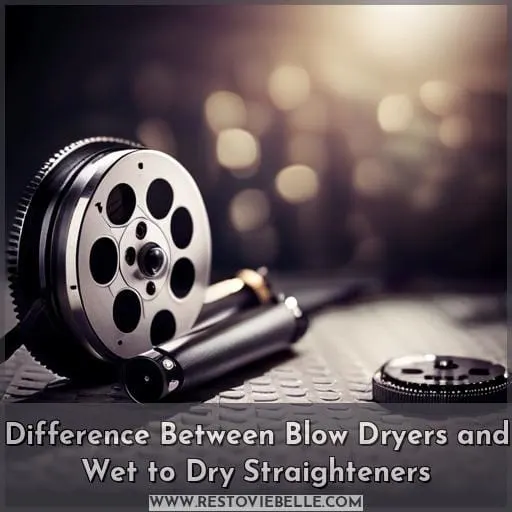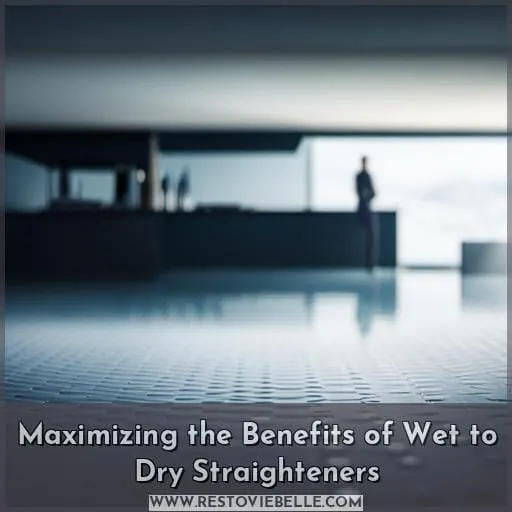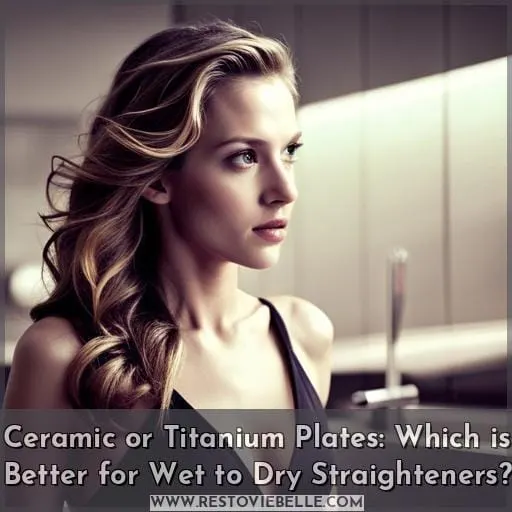This site is supported by our readers. We may earn a commission, at no cost to you, if you purchase through links.
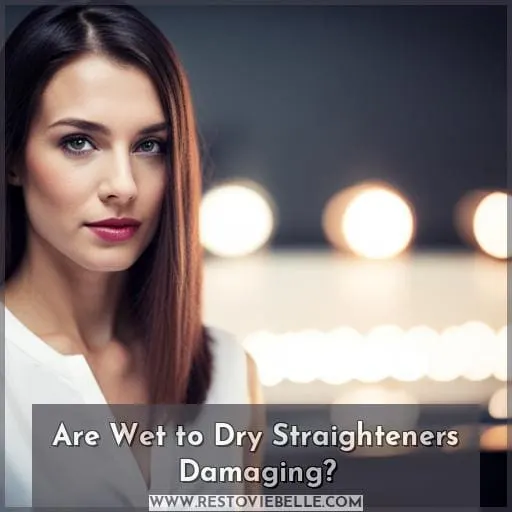 Do you ever feel like you don’t have enough time in the morning to style your hair? If so, wet-to-dry straighteners are a great solution.
Do you ever feel like you don’t have enough time in the morning to style your hair? If so, wet-to-dry straighteners are a great solution.
In this article, we’ll discuss whether or not these devices are bad for our manes and look at ways to maximize their benefits while reducing potential damage.
Table Of Contents
- Key Takeaways
- Can Wet to Dry Straighteners Damage Hair?
- Proper Usage of Wet to Dry Straighteners to Prevent Damage
- Choosing the Right Wet to Dry Straightener
- Can You Straighten Wet Hair?
- Benefits of Wet to Dry Straighteners
- How Do Wet to Dry Straighteners Work?
- Difference Between Blow Dryers and Wet to Dry Straighteners
- Maximizing the Benefits of Wet to Dry Straighteners
- Ceramic or Titanium Plates: Which is Better for Wet to Dry Straighteners?
- Conclusion
Key Takeaways
- Wet-to-dry straighteners offer time-saving benefits and reduce heat damage compared to regular flat irons.
- Proper usage and quality products are essential to prevent long-term damage.
- Consider factors like plate type and moisture balance for safe and effective use.
- Limit the frequency of use to prevent overuse and potential hair breakage.
Can Wet to Dry Straighteners Damage Hair?
If you’re looking for a quick and easy way to style your hair, using wet to dry straighteners can be tempting. However, it’s important to consider the potential damage that could be caused by heat styling on wet or damp hair.
Steam technology is used in these tools, which helps reduce water content from the strands. But due to their high temperature settings, they can still cause irreparable damage if not used properly.
The fragility of wet hair requires extra care when using heat protection sprays and adjusting plate material settings accordingly. It’s also essential that users are aware of proper usage tips, such as avoiding holding devices too close to the scalp area and setting temperatures correctly according to their individual strand type and size of plates chosen (ceramic or titanium).
Though time-saving benefits exist with this tool, along with reduced damage compared to regular flat irons, its use should always be considered carefully due to possible long-term consequences associated with continuous exposure.
Proper Usage of Wet to Dry Straighteners to Prevent Damage
When it comes to using wet-to-dry straighteners, proper usage is essential for preventing damage. Be sure to apply a heat protectant before styling and avoid applying heat to soaking wet hair; instead, towel-dry or rough-dry your hair first.
Use Heat Protectant
Before using a wet to dry straightener, make sure you apply a heat protectant for maximum protection. Heat protectants shield hair from the high temperatures of styling tools and keep moisture levels balanced.
When used correctly, they can help prevent breakage and damage when styling with wet to dry straighteners or other hot tools.
For best results, look for products specifically formulated for use on damp hair that also contain nourishing ingredients such as oils and vitamins.
Towel Dry or Rough Dry Hair First
Before heat styling, give your hair a good towel dry or rough dry to reduce the risk of damage. Rough drying techniques can help remove extra moisture and preserve hair health. There are several methods you can try, such as using a t-shirt instead of a towel or scrunching with an old cotton shirt for curls.
It’s important to use heat protection sprays before applying any wet to dry straighteners. This will protect your delicate strands from high temperatures and prevent breakage. Not only does it save time compared to regular straightening, but it also reduces damage thanks to steam technology that quickly removes excess water without causing harm.
Avoid Holding Too Close to Scalp
Be careful not to hold the straightener too close to your scalp when using wet-to-dry styling tools, as this can cause burns. Invest in a quality product with ceramic or titanium plates – both options offer protection from burning and damage due to their even heat distribution.
Also, consider plate size. Smaller ones are suitable for short hair, while larger plates work better on long locks.
To protect your hair further, use a heat protectant before applying any kind of direct heat styling tool.
Keep these tips in mind for safe wet hair care that won’t lead to damaging results over time!
Choosing the Right Wet to Dry Straightener
When choosing a wet-to-dry straightener, it is important to consider the plate type (ceramic or titanium) as well as how frequently you plan on using it. Always use safety precautions and avoid applying heat directly to dripping wet hair in order to prevent damage.
Plate type: Ceramic or Titanium?
When choosing a wet to dry straightener, consider the plate type – ceramic or titanium – for best results. Ceramic plates generate far-infrared heat and are gentler on hair, while titanium plates are fast-heating and ideal for thick or coarse locks.
Each plate type has its own advantages when it comes to heat control, styling options, and hair protection. It is important to use a heat protectant before using a wet to dry straightener, as wet hair is fragile.
With the right tools at hand, you can choose the perfect plate material without compromising on style or safety.
Frequency of use
It’s important to remember that wet-to-dry straighteners should be used sparingly since frequent use can damage your luscious locks. To keep hair healthy, it’s best to limit their use and opt for alternative styling methods.
For example, you can blow dry with a round brush or use a heat protectant before applying heat. If you do choose to go the wet-to-dry route, make sure you set the temperature correctly and don’t hold it too close to your scalp.
Taking breaks in between uses may also help reduce long-term effects on hair health from overuse of these tools. Keep in mind that while they offer time savings compared with regular flat irons or blow dryers, this doesn’t necessarily mean less damage.
Safety precautions
Take extra precaution when using a wet to dry straightener; use heat protection and keep the tool away from your scalp to avoid burning!
Drying techniques should be tailored according to hair type, while plate selection is key for even heat distribution.
Moisture loss can cause damage over time, so it’s important to select a straightener that locks in natural oils.
Hair safety must also come first – invest in quality tools and avoid applying direct heat on dripping wet strands.
To get the best results out of your styling session without damaging hair, follow these steps with all types of wet-to-dry straighteners.
Can You Straighten Wet Hair?
You can use wet to dry straighteners to give your hair a sleek, smooth style without inflicting long-term damage.
Towel dry or rough dry your hair first before using the wet to dry straightener; this will reduce moisture and eliminate frizziness when styling.
Choose the right temperature setting on your appliance depending on how thick or coarse your hair is; higher settings may cause heat damage over time if used too frequently.
Consider plate type (ceramic/titanium) and size when selecting a suitable product for you as they affect performance and efficiency of styling damp strands quickly with minimal effort required from users’ side.
Finally, always apply a heat protectant prior to using any hot tools such as blow-dryers or flat irons in order to prevent further damage caused by direct contact with high temperatures!
Benefits of Wet to Dry Straighteners
Straightening wet hair can be a time-consuming task using regular straighteners, but with the advent of wet-to-dry straighteners, you can achieve salon-quality results in much less time while minimizing damage compared to traditional methods.
Time-Saving
Savvy stylists swear by wet to dry straighteners because they save time while delivering superior results. With a heat protectant and the right temperature setting, you can quickly and safely straighten your hair when it’s damp.
Ceramic or titanium plates are available depending on your preference. Ceramic plates heat up faster than titanium ones but cause more damage over time due to their higher temperatures.
The Remington Wet2Straight Flat Iron is an ideal choice for this type of styling. It features nano combs for even heating distribution and a venting system that helps remove excess water from wet strands fast without sacrificing smoothness or shine.
Forget about blow drying then flat ironing – go from air-dried curls to sleek locks in no time with a wet-to-dry product like this one!
Reduced Damage Compared to Regular Straighteners
Compared to a regular flat iron, wet to dry straighteners reduce the risk of heat-related damage and leave your locks looking salon fresh. They provide hair protection by not applying direct heat from the plates and allow for more precise styling.
The adjustable temperature settings mean you can choose a level that is best suited for your hair type so you don’t overheat it. Plus, there are different plate options such as ceramic or titanium, both of which have their own benefits in terms of speed and gentleness on delicate strands.
Damage control is also possible when using wet to dry straighteners since they evenly distribute heat through dampened tresses rather than frying them with high temperatures like traditional flat irons do.
How Do Wet to Dry Straighteners Work?
By harnessing steam technology to remove excess water from damp hair, wet to dry straighteners allow you to quickly and safely achieve a smooth, sleek style.
- Apply heat protection spray before styling.
- Set the straightener on ‘wet’ mode and choose the right temperature for your hair type.
- Certain models of flat irons have ceramic or titanium plates that provide even heat distribution.
- Detangling combs can also be found on certain models of flat irons.
- Avoid holding the straightener too close to the scalp to prevent burns. Take proper precautions against hair damage caused by high temperatures due to the wetness of your locks.
Using a quality product with careful consideration towards plate type and size, along with correct usage techniques, is necessary to prevent long-term harm caused by hot air exposure when using this tool as an alternative method for drying your tresses compared to other blow drying devices.
These devices might cause less damage but take a longer time period until the desired result is achieved.
Difference Between Blow Dryers and Wet to Dry Straighteners
When considering whether wet to dry straighteners are bad for your hair, it is important to understand the advantages and disadvantages of these tools. Wet to dry straighteners can save time in styling, reduce heat damage compared to regular flat irons, and provide even heat distribution due to nano combs.
However, there is an increased risk of burning or breakage when using them, as well as potential long-term damage from overuse.
Advantages of Wet to Dry Straighteners
Unbeknownst to many, wet-to-dry straighteners can offer plenty of advantages over regular flat irons and blow dryers. Wet hair styling is much kinder than traditional methods as the steam vents help reduce damage from overheating.
Plus, ceramic or titanium plates provide even heat distribution for better results with less effort. Furthermore, these plate types are suitable for all hair types and textures while providing extra protection against heat damage when used correctly.
For added convenience, some models also come with a detangling comb feature, which helps make styling easier and faster.
Disadvantages of Wet to Dry Straighteners
Although wet to dry straighteners can be a great time-saver, they come with drawbacks that could damage your locks. Overuse of these tools can strip hair of its natural moisture balance and cause split ends or breakage.
Heat protection sprays are essential but not enough to prevent long-term damage from high temperatures.
Alternatives such as blow drying with a round brush may take longer but will help maintain hair health in the long run.
Maximizing the Benefits of Wet to Dry Straighteners
When using wet-to-dry straighteners, it is essential to select the right temperature setting. Not only will this help prevent heat damage, but also ensure efficient styling without compromising hair health.
It is important to remember that wet hair can be fragile, and extra caution should be taken when using a heated tool on it.
Choosing the right temperature
When choosing a wet to dry straightener, it’s important to select the temperature setting that best suits your hair type and texture. Too hot can be as damaging as too cold. For heat protection, consider using a lower setting if you have fine or damaged hair and the highest for coarse or thick locks.
Opting for ceramic plates is recommended because they generate far-infrared heat, which reduces damage while providing efficient styling. Titanium plates are suitable for thicker textures but should still be used with caution due to their fast heating capabilities.
Whatever plate material you choose, make sure it’s accompanied by adjustable settings.
Plate type considerations
You’ll want to consider plate type when choosing a wet to dry straightener for your hair. Ceramic or titanium plates can make all the difference. Ceramic produces far-infrared heat, which is milder than direct heat from titanium and thus better suited for fine hair types.
Titanium heats up quickly and works well on thicker/coarser textures. Heat protection products are key; they shield strands against damage while styling at high temperatures with steam technology used by many tools today.
Frequency of use should be kept in mind too. Maintaining moisture balance will help prevent breakage over time as dampening can lead to additional vulnerability if not managed correctly! Plate material matters most, so choose wisely between ceramic vs titanium depending on your specific needs for healthy-looking locks!
Minimizing long-term damage
To maximize the benefits of wet to dry straighteners, minimize long-term damage with responsible usage and quality products – swiftly styling your locks without breakage.
Wet hair is fragile and more prone to heat damage than dry, so use a low temperature setting on the straightener.
Invest in good quality ceramic plates for far infrared heat, which is gentler on hair while ensuring an even distribution of heat for better results.
Additionally, don’t forget to apply a protective spray before using any type of heated tool and finish off with oil or conditioner for moisture retention.
Ceramic or Titanium Plates: Which is Better for Wet to Dry Straighteners?
When it comes to wet-to-dry straighteners, there’s a choice between ceramic or titanium plates. Ceramic plates generate far-infrared heat for gentler styling, while titanium is fast-heating and better suited for thick or coarse hair strands.
It’s important to consider which one will work best given your hair type and texture before investing in a product.
Ceramic Plates
Ceramic plates on wet to dry straighteners offer maximum protection for your hair. They release far-infrared heat, which helps seal in moisture and reduce the risk of damage. Compared to titanium plates, ceramic ones reach a lower temperature more quickly while preventing heat overload.
When used with appropriate styling techniques and proper heat settings, ceramic plates can protect fragile strands from breakage or split ends. Your hair will be left looking smooth and shiny without compromising its health over time.
Ceramic also has an advantage over other plate materials. It is less likely to snag or pull at hair during styling sessions due to its even heating surface texture.
Titanium Plates
Titanium plates are a popular choice for wet-to-dry straightening due to their ability to generate and maintain high heat quickly. Titanium plate benefits include quick styling, being suitable for thick hair, good compatibility with heat styling options, and longer-lasting than ceramic plates.
Plate material comparison shows that titanium is harder than ceramic but more prone to damage if handled carelessly. It’s also better at maintaining consistent temperatures during use, which makes it ideal for achieving the sleek look of wet-to-dry straightening faster without compromising hair health or causing excessive drying of the strands.
Conclusion
When it comes to the question, are wet to dry straighteners damaging, the answer is not a simple one. While wet to dry straighteners offer the advantage of time-saving and reduced damage compared to regular straighteners, they can be damaging if not used properly.
To maximize the benefits of wet to dry straighteners, it’s important to choose the right temperature, plate type, and frequency of use. Ceramic plates generate far-infrared heat and are gentler on the hair, while titanium plates are fast-heating and suitable for thick or coarse hair.
With the right knowledge and precautions, wet to dry straighteners can be used safely and effectively for beautiful, healthy-looking hair.
